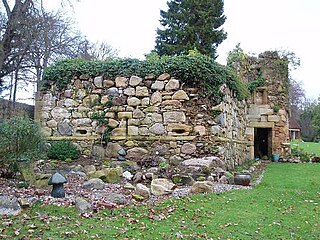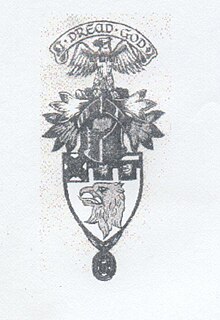Related Research Articles

Castle Chanonry of Ross, also known as Seaforth Castle, was located in the town of Fortrose, to the north-east of Inverness, on the peninsula known as the Black Isle, Highland, Scotland. Nothing now remains of the castle. The castle was also known as Canonry or Chanonrie of Ross, the former county.

Newmore Castle is situated just north of the town of Alness in Ross and Cromarty, Highland, Scotland.
The Munros of Milntown were a family cadet branch of the Highland Clan Munro. As the earliest recorded cadet branch of the Munro chiefs, the Munros of Milntown were the 'senior' cadet branch of the clan, and spawned many cadet branches. They were frequently recorded as 'Monro' as well as Munro. The Munros of Milntown are notable for being involved in events concerning the history of the late Middle Ages in the Scottish Highlands.
Sir Robert Munro, 5th Baronet of Foulis was also 23rd Baron and 26th chief of the Clan Munro. He became blind and was known as the Blind Baron.

Kiltearn is a parish in Ross and Cromarty, Scotland. It is in the Presbytery of Ross.

The Battle of Achnashellach was a Scottish clan battle said to have taken place in the year 1505, in the Scottish Highlands at Achnashellach. It was fought by the Clan Cameron against the Clan Mackay and the Clan Munro.

The Battle of Logiebride or Logie-Riach, also known as a Tumult in Ross was more of a small skirmish rather than an actual battle. The disturbance is said to have taken place on 4 February 1597 at the Logie Candlemas market near Conan House between men of the Clan Mackenzie against men of the Clan Munro and the Bain family of Tulloch Castle.

Milntown Castle was an early 16th-century castle which was situated near Milton, in Easter Ross, in the Scottish Highlands.
Robert Mor Munro, 15th Baron of Foulis, and 18th chief of the Clan Munro was a 16th-century Scottish chief. He was known as Robert Mor on account of his large stature. He was the eldest son of Robert Munro, 14th Baron of Foulis. Although this Robert Munro is traditionally 15th Baron and 18th overall chief of the clan, he is only the 8th Munro chief that can be proved by contemporary evidence.
Hugh Munro, 9th Baron of Foulis was a 14th – 15th century Scottish soldier and said to be 12th chief of the Clan Munro in the Scottish Highlands. Hugh was seated at Foulis Castle in Ross-shire, Scotland. Although Hugh is traditionally the 9th Baron and 12th overall chief of the clan, he is only the 2nd Munro chief that can be proved by contemporary evidence.
Sir Robert Munro, 3rd Baronet of Foulis, 21st Baron and 24th chief of the Clan Munro was a 17th-century Scottish soldier and politician.
Robert Munro, 14th Baron of Foulis was a Scottish soldier and clan chief of the Highland Clan Munro. He was seated at Foulis Castle. Although he is traditionally the 14th Baron and 17th overall chief of the clan, he is only the 7th Munro chief that can be proved by contemporary evidence.

Dingwall Castle was a medieval fort and royal castle in the town of Dingwall, eastern Ross-shire, Scotland.
George Munro of Foulis is traditionally the 10th Baron and 13th successive chief of the Clan Munro. However, he is only the third successive chief of the clan who can be proved by contemporary evidence. He was the eldest son of Hugh Munro, 9th Baron of Foulis and was seated at Foulis Castle.
John Munro of Foulis was a Scottish clan chief of the highland Clan Munro in Rosshire, Scotland. He is by tradition the 11th Baron of Foulis and 14th overall chief of the clan. However, he is actually only the 4th chief of the Clan Munro who can be proved by contemporary evidence.
Sir William Munro of Foulis was a Scottish Knight and Scottish clan chief of the highland Clan Munro. He is by tradition the 12th Baron of Foulis and 15th overall chief of the clan. However, he is actually only the 5th chief of the Clan Munro who can be proved by contemporary evidence.
Hector Munro, 13th Baron of Foulis was a Scottish clan chief of the highland Clan Munro in Rosshire. He is by tradition 13th Baron of Foulis and 16th overall chief of the clan. However, he is only the 6th chief of the Clan Munro who can be proved by contemporary evidence.

The Munros of Obsdale were a Scottish family and a cadet branch of the Clan Munro, a Highland Scottish clan. Their base was at Obsdale House, situated just north of the town of Alness in the Scottish Highlands. Some of the members of the Munro of Obsdale family were amongst the most distinguished Scottish military officers of the 17th century.

Clan Munro is a Highland Scottish clan. Historically the clan was based in Easter Ross in the Scottish Highlands. Traditional origins of the clan give its founder as Donald Munro who came from the north of Ireland and settled in Scotland in the eleventh century, though its true founder may have lived much later. It is also a strong tradition that the Munro chiefs supported Robert the Bruce during the Wars of Scottish Independence. The first proven clan chief on record however is Robert de Munro who died in 1369; his father is mentioned but not named in a number of charters. The clan chiefs originally held land principally at Findon on the Black Isle but exchanged it in 1350 for Estirfowlys. Robert's son Hugh who died in 1425 was the first of the family to be styled "of Foulis", despite which clan genealogies describe him as 9th baron.
Hector Munro, 17th Baron of Foulis, also known as the master of Foulis, was a Scottish chief of the Highland, Scottish clan, Clan Munro. He is the 10th chief of Clan Munro who can be proved by contemporary evidence. He was seated at Foulis Castle.
References
- ↑ "MHG8021 - Contullich Castle". highland.gov.uk. Retrieved May 17, 2014.
- ↑ Coventry, Martin (2008). Castles of the Clans: The Strongholds and Seats of 750 Scottish Families and Clans. Musselburgh: Goblinshead. p. 441. ISBN 978-1-899874-36-1.
- ↑ Mackenzie, Alexander (1898). History of the Munros of Fowlis. Inverness: A. & W. Mackenzie. p. 14 . Retrieved February 12, 2022.
- 1 2 3 Munro, R.W (1987). Mapping the Clan Munro. Edinburgh: Clan Munro (Association). Printed by Lindsay & Co Ltd.
- ↑ Mackenzie, Alexander (1898). History of the Munros of Fowlis. Inverness: A. & W. Mackenzie. p. 267 . Retrieved February 12, 2022.
- ↑ Mackenzie, Alexander (1898). History of the Munros of Fowlis. Inverness: A. & W. Mackenzie. pp. 431-433. Retrieved February 12, 2022.